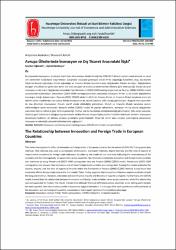Avrupa ülkelerinde inovasyon ve dış ticaret arasındaki ilişki
Citation
Ağazade, S. & Karakaya, A. (2022). Avrupa Ülkelerinde İnovasyon ve Dış Ticaret Arasındaki İlişki. Hacettepe Üniversitesi İktisadi ve İdari Bilimler Fakültesi Dergisi, 40(3), 472-493. https://doi.org/10.17065/huniibf.1003460Abstract
Öz
Bu çalışmada inovasyonun dış ticaret üzerindeki etkisi Avrupa ülkeleri örneğinde 2000-2017 dönemi verileri temel alınarak ve panel
veri yöntemleri kullanılarak araştırılmıştır. Çalışmada inovasyon göstergesi olarak Ar-Ge yoğunluğu kullanılmış olup, dış ticarete
ilişkin ise ihracat yoğunluğu, ithalat yoğunluğu ve ihracatın ithalatı karşılama oranı değişkenleri dikkate alınmıştır. Değişkenlerin
durağan olmadıklarına işaret eden birim kök testi sonuçları ve model parametrelerinin ülkelere göre heterojenliği dikkate alınarak
inovasyon ve dış ticaret değişkenleri arasındaki ilişki Westerlund (2007) HDM koentegrasyon testi ve Pesaran (2006) CCEMG modeli
çerçevesinde incelenmiştir. Westerlund (2007) HDM koentegrasyon testi sonucunda, inovasyon ile her üç dış ticaret değişkeninin
koentegre olduğu bulunmuştur. Pesaran (2006) CCEMG yöntemi dâhilinde ihracat, ithalat ve ihracatın ithalatı karşılama oranı için
tahmin edilen modellerden ise sadece ilkinde inovasyonun dış ticaret üzerinde etkili olduğu görülmüştür. Bulgular hem uzun hem
de kısa dönemde inovasyonun ihracatı pozitif yönde etkilediğini gösterirken, ithalatı ve ihracatın ithalatı karşılama oranını
etkilemediğine işaret etmektedir. Bununla birlikte CCEMG modeli ile yapılan tahminlerle, inovasyon ve dış ticaret değişkenleri
arasındaki ilişkinin ülkelere göre farklılık gösterdiği, Türkiye için ise bu ilişkinin desteklenmediği görülmüştür. Elde edilen sonuçlar,
ülkelere göre farklılıkların olduğuna işaret etmekle birlikte ihracat artışına ilişkin politika hedefleri belirleyen ülkelerin inovasyonu
destekleyici tedbirleri de dikkate almaları gerektiğini göstermektedir. Böyle bir tercih kalıcı rekabet üstünlüğünü destekleyen
inovasyon ve teknolojik yetenek birikimine katkı sağlayabilir. This study investigates the effect of innovation on foreign trade in European countries for the period of 2000-2017 using panel data
methods. R&D intensity was used as an indicator of innovation, and export intensity, import intensity and the ratio of exports to
imports were considered as foreign trade indicators. Considering the results of unit root tests indicating the nonstationary of the
variables and the heterogeneity of parameters across countries, the relationship between innovation and foreign trade variables
was examined by using Westerlund (2007) HDM cointegration test and Pesaran (2006) CCEMG model. Westerlund (2007) HDM
cointegration test showed that innovation and all three foreign trade variables are cointegrated. Among the models estimated for
exports, imports, and the ratio of exports to imports within the framework of Pesaran (2006) CCEMG method, it was found that
innovation affects foreign trade only in the first model. These finding supports that innovation influences exports positively in both
the long and short run. However, innovation did not influence imports and the ratio of exports to imports. Furthermore, the CCEMG
model showed that the relationship between innovation and foreign trade variables varies across countries, while this relationship
was not supported for Turkey. The results indicate that although there are differences across countries, when setting policy targets
for export growth, they should also consider measures to support innovation. It is thought that such a preference will contribute to
the innovation and technological capability accumulation that support permanent competitive advantage.


















